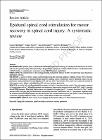| dc.contributor.author | Fleming, Neil | |
| dc.contributor.author | Mockler, David | |
| dc.contributor.author | Taylor, Clare | |
| dc.contributor.author | Fleming, Neil | |
| dc.date.accessioned | 2021-07-13T20:24:19Z | |
| dc.date.available | 2021-07-13T20:24:19Z | |
| dc.date.issued | 2021 | |
| dc.date.submitted | 2021 | en |
| dc.identifier.citation | McHugh, C., Taylor, C., Mockler, D., Fleming, N., Epidural Spinal Cord Stimulation for motor recovery in SCI: A Systematic Review, Neurorehabilitation, 2021 | en |
| dc.identifier.other | Y | |
| dc.identifier.uri | http://hdl.handle.net/2262/96745 | |
| dc.description.abstract | Background. Epidural spinal electrical stimulation at the lumbar spinal level evokes rhythmic muscle activation of lower-limb antagonists, attributed to the central pattern generator. However, the efficacy of noninvasive spinal stimulation for the activation of lower-limb muscles is not yet clear. This review aimed to analyze the feasibility and efficacy of noninvasive transcutaneous spinal cord stimulation (tSCS) on motor function in individuals with spinal cord injury. Methods. A search for tSCS studies was made of the following databases: PubMed; Cochrane Registry; and Physiotherapy Evidence Database (PEDro). In addition, an inverse manual search of the references cited by the identified articles was carried out. The keywords transcutaneous, non-invasive, electrical stimulation, spinal cord stimulation [Mesh term], and spinal cord injury were used. Results. A total of 352 articles were initially screened, of which 13 studies met the inclusion criteria for systematic review. The total participant sample comprised 55 persons with spinal cord injury. All studies with tSCS provided evidence of induced muscle activation in the lower and upper limbs, and applied stimulation at the level of the T11-T12 and C4-C7 interspinous space, respectively. All studies reported an increase in motor response measured by recording surface electromyography, voluntary movement, muscle strength, or function. Conclusions. Although this review highlights tSCS as a feasible therapeutic neuromodulatory strategy to enhance voluntary movement, muscle strength, and function in patients with chronic spinal cord injury, the clinical impact and efficacy of electrode location and current intensity need to be characterized in statistically powered and controlled clinical trials. | en |
| dc.language.iso | en | en |
| dc.relation.ispartofseries | Neurorehabilitation; | |
| dc.rights | Y | en |
| dc.subject | Motor activity | en |
| dc.subject | Neurological rehabilitation | en |
| dc.subject | Neuromodulation | en |
| dc.subject | Spinal cord injury | en |
| dc.subject | Transcutaneous spinal cord stimulation | en |
| dc.title | Epidural Spinal Cord Stimulation for motor recovery in SCI: A Systematic Review | en |
| dc.type | Journal Article | en |
| dc.type.supercollection | scholarly_publications | en |
| dc.type.supercollection | refereed_publications | en |
| dc.identifier.peoplefinderurl | http://people.tcd.ie/nflemin | |
| dc.identifier.rssinternalid | 232114 | |
| dc.identifier.doi | 10.3233/NRE-210093 | en |
| dc.rights.ecaccessrights | openAccess | |
| dc.subject.TCDTheme | Neuroscience | en |
| dc.subject.TCDTheme | Next Generation Medical Devices | en |
| dc.identifier.rssuri | https://content.iospress.com/articles/neurorehabilitation/nre210093 | |
| dc.subject.darat_impairment | Mobility impairment | en |
| dc.subject.darat_impairment | Physical disability | en |
| dc.subject.darat_impairment | Sensory impairment | en |
| dc.subject.darat_thematic | Health | en |
| dc.status.accessible | N | en |
| dc.rights.restrictedAccess | Y | |
| dc.date.restrictedAccessEndDate | 2022-07-01 | |




